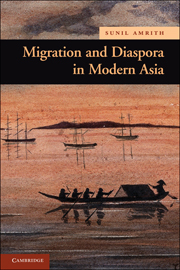Book contents
- Frontmatter
- Contents
- List of Plates, Tables, and Maps
- Acknowledgements
- Select Timeline
- Glossary
- Maps
- Introduction
- 1 Asia's Great Migrations, 1850–1930
- 2 The Making of Asian Diasporas, 1850–1930
- 3 War, Revolution, and Refugees, 1930–1950
- 4 Migration, Development, and the Asian City, 1950–1970
- 5 Asian Migrants in the Age of Globalization, 1970–2010
- Conclusion
- Guide to Further Reading
- Index
Conclusion
Published online by Cambridge University Press: 05 June 2012
- Frontmatter
- Contents
- List of Plates, Tables, and Maps
- Acknowledgements
- Select Timeline
- Glossary
- Maps
- Introduction
- 1 Asia's Great Migrations, 1850–1930
- 2 The Making of Asian Diasporas, 1850–1930
- 3 War, Revolution, and Refugees, 1930–1950
- 4 Migration, Development, and the Asian City, 1950–1970
- 5 Asian Migrants in the Age of Globalization, 1970–2010
- Conclusion
- Guide to Further Reading
- Index
Summary
I have argued in this book that migration has shaped modern Asia. At the dawn of Asia's first age of mass migration, which began in the second half of the nineteenth century, large parts of Asia – Manchuria, the Malay Peninsula, Sumatra – were still sparsely populated. Within half a century, these regions were home to millions. New cities, new forms of intensive agriculture, and new societies emerged. The losers from the new order were, usually, small and mobile communities. The winners were invariably states, and – in different and unequal measures – diasporas, settled peasantries, and urban residents, who benefited from new economic opportunities.
People on the move have taken with them ideas, cultural practices, political movements, social institutions, and religious faith. These ideas and practices have changed in the process of circulation, and they have changed the societies in which they implanted themselves. In studying the history of attempts to control migration, I have also touched on core aspects of state-formation in modern Asia: the drawing of imperial and national borders; the development of new ideas about citizenship; states' increasing concern with knowing, and acting upon, their populations.
- Type
- Chapter
- Information
- Migration and Diaspora in Modern Asia , pp. 193 - 200Publisher: Cambridge University PressPrint publication year: 2011



